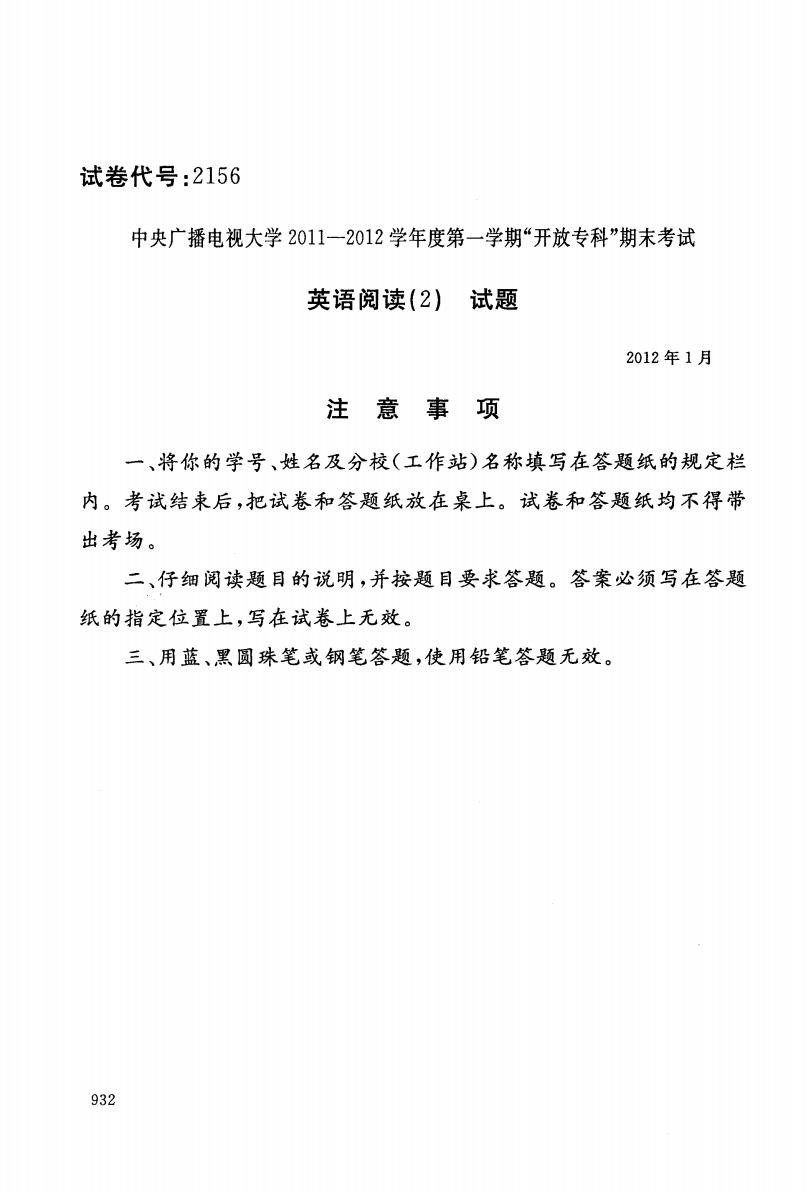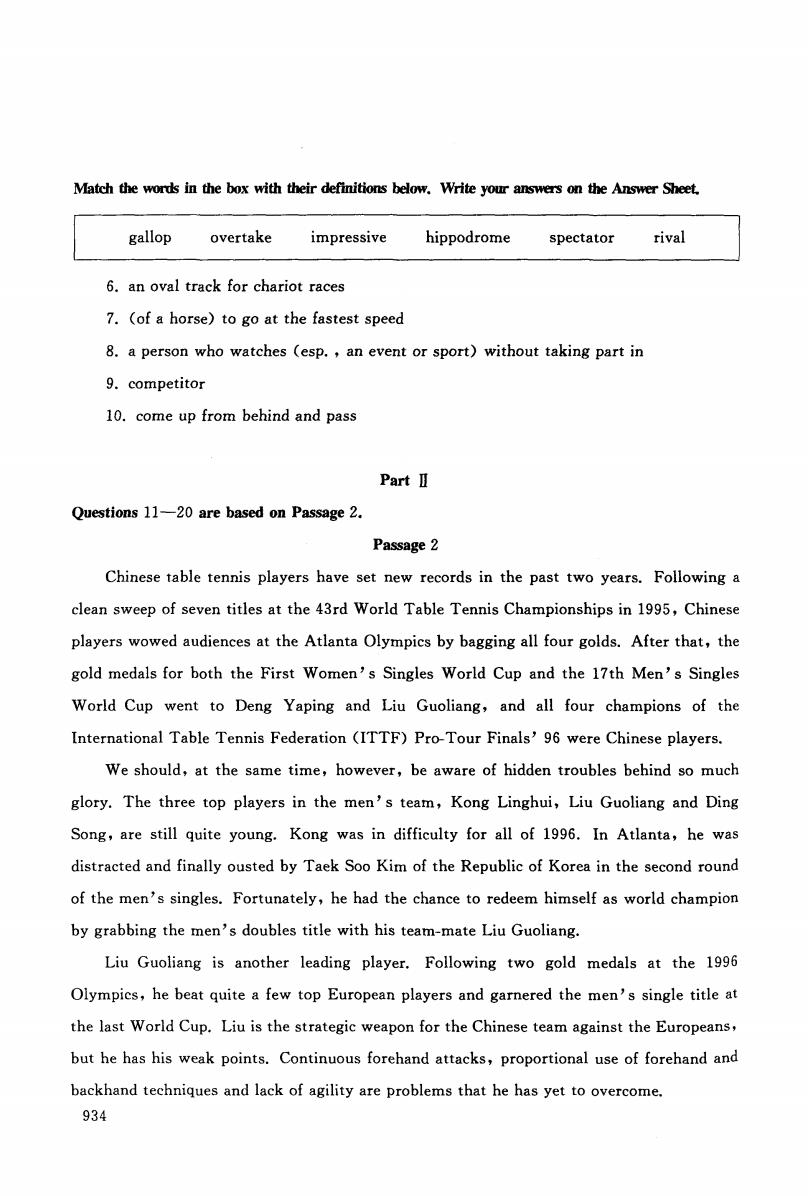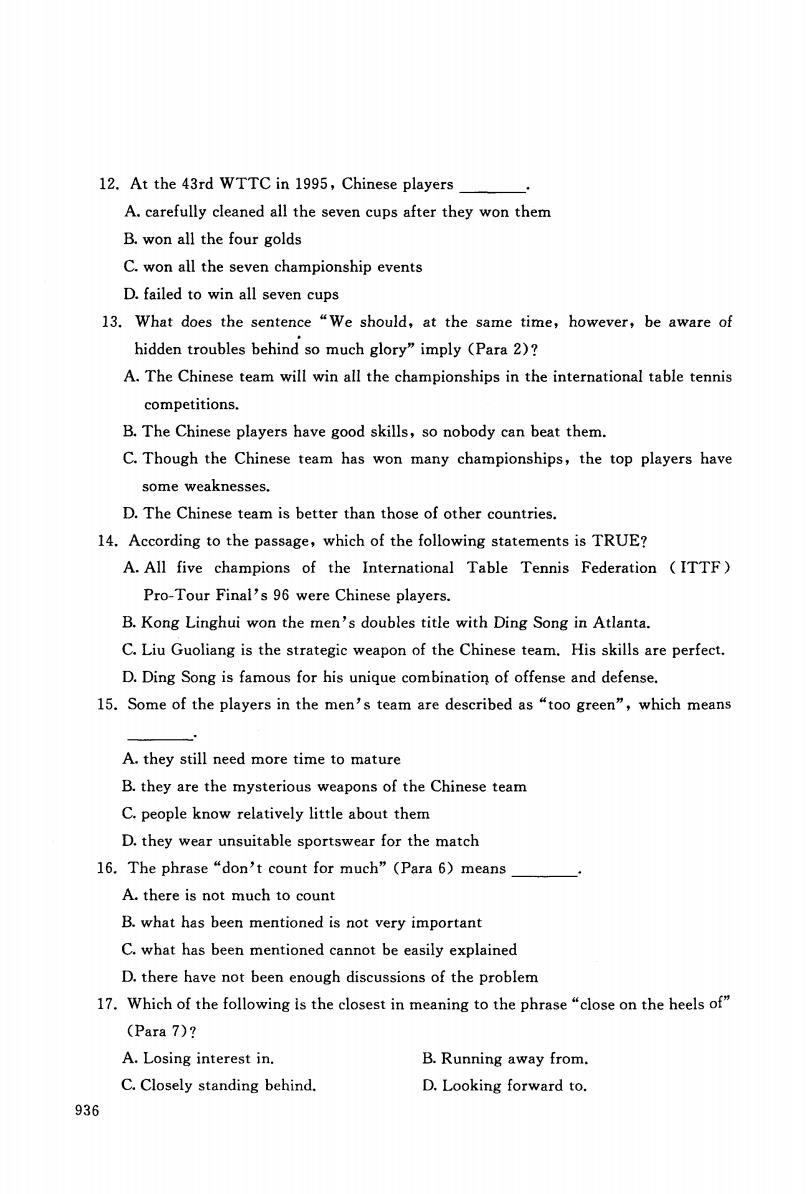
试卷代号:2156 中央广播电视大学2011一2012学年度第一学期“开放专科”期末考试 英语阅读(2)试题 2012年1月 注意事项 一、将你的学号、姓名及分校(工作站)名称填写在答题纸的规定栏 内。考试结束后,把试卷和答题纸放在桌上。试卷和答题纸均不得带 出考场。 二、仔细阅读题目的说明,并按题目要求答题。答案必须写在答题 纸的指定位置上,写在试卷上无效。 三、用蓝、黑圆珠笔或钢笔答题,使用铅笔答题无效。 932
试卷代号 中央广播电视大学 11 2学年度第一学期"开放专科"期末考试 英语阅读 )试题 2012 年1 注意事项 一、将你的学号、姓名及分校(工作站)名称填写在答题纸的规定栏 内。考试结束后,把试卷和答题纸放在桌上。试卷和答题纸均不得带 出考场。 二、仔细阅读题目的说明,并按题目要求答题。答案必须写在答题 纸的指定位置上,写在试卷上无效。 三、用蓝、黑圆珠笔或钢笔答题,使用铅笔答题无效。 932

Part I Questions 1-10 are based on Passage 1. Passage 1 Passage 1 is about the chariot races which were an important part of the Olympic Games. Think of a chariot race and you probably think of excited horses racing round a dusty track with determined charioteers waving their whips.You imagine the noisy spectators cheering or jeering as a chariot turns over on a bend or their favorite charioteer overtakes his rival.Most of us can imagine the sight and sounds of the race quite vividly. For those lucky spectators who saw the chariot races,which were the first events in the Olympic Games,it was an impressive sight and,for many people it was the best bit of the whole five-day Games. After a staggered start,controlled by a starting gate which opened gradually from the outside of the line to the middle,the chariots raced down to the other end of the hippodrome where they had to go round the turning post before galloping back and going round another post near the start.The best charioteers were those who could make their horses go fastest on the straight sections and turn very neatly round the posts. On each occasion,there were four different kinds of race-two or four horse chariots using young or older horses.Often the distance to be covered was as much as 12 kilometers. The chariots they used were made of lightweight wood or basketwork,which they decorated with paint or colorful metal.The men who drove the horses were professional charioteers who got paid large sums to compete.Like in today's horse racing,the prize went to the owner of the chariot,not the charioteer. Read Passage 1 and answer the following questions.Write your answers on the Answer Sheet. 1.What's the spectators'response when a chariot turns over on a bend or their favorite charioteer overtakes his rival? 2.What were the first events in the Olympic Games? 3.How many kilometers were often covered in the chariot race? 4.Who drove the horses in the chariot race? 5.Who did the prize go to in the chariot race? 933
Part I Qu臼tions 1-10 based on Passage 1. Passage 1 Passage 1 is about the chariot rac臼which were an important part of the Olympic Games. Think of a chariot race and you probably think of excited horses racing round a dusty track with determined charioteers waving their whips. You imagine the noisy spectators cheering or jeering as a chariot turns over on a bend or their favorite charioteer overtakes his rival. Most of us can imagine the sight and sounds of the race quite vividly. For those lucky spectators who saw the chariot races, which were the first events in the Olympic Games, it was an impressive sight and , for many people it was the best bit of the whole five-day Games. After a staggered start , controlled by a starting gate which opened gradually from the outside of the line to the middle , the chariots raced down to the other end of the hippodrome where they had to go round the turning post before galloping back and going round another post near the start. The best charioteers were those who could make their horses go fastest on the straight sections and turn very neatly round the posts. On each occasion, there were four different kinds of race 一two or four horse chariots using young or older horses. Often the distance to be covered was as much as 12 kilometers. The chariots they used were made of lightweight wood or basketwork , which they decorated with paint or colorful metal. The men who drove the horses were professional charioteers who got paid large sums to compete. Like in today' s horse racing , the prize went to the owner of the chariot , not the charioteer. Read Passage 1 and answer the following questions. Write your answers on the Answer Sheet. 1. What's the spectators' response when a chariot turns over on a bend or their favorite charioteer overtakes his rival? 2. What were the first events in the Olympic Games? 3. How many kilometers were often covered in the chariot race? 4. Who drove the horses in the chariot race? 5. Who did the prize go to in the chariot race? 933

Match the words in the box with their definitions below.Write your answers on the Answer Sheet. gallop overtake impressive hippodrome spectator rival 6.an oval track for chariot races 7.(of a horse)to go at the fastest speed 8.a person who watches (esp.,an event or sport)without taking part in 9.competitor 10.come up from behind and pass Part I Questions 11-20 are based on Passage 2. Passage 2 Chinese table tennis players have set new records in the past two years.Following a clean sweep of seven titles at the 43rd World Table Tennis Championships in 1995,Chinese players wowed audiences at the Atlanta Olympics by bagging all four golds.After that,the gold medals for both the First Women's Singles World Cup and the 17th Men's Singles World Cup went to Deng Yaping and Liu Guoliang,and all four champions of the International Table Tennis Federation (ITTF)Pro-Tour Finals'96 were Chinese players. We should,at the same time,however,be aware of hidden troubles behind so much glory.The three top players in the men's team,Kong Linghui,Liu Guoliang and Ding Song,are still quite young.Kong was in difficulty for all of 1996.In Atlanta,he was distracted and finally ousted by Taek Soo Kim of the Republic of Korea in the second round of the men's singles.Fortunately,he had the chance to redeem himself as world champion by grabbing the men's doubles title with his team-mate Liu Guoliang. Liu Guoliang is another leading player.Following two gold medals at the 1996 Olympics,he beat quite a few top European players and garnered the men's single title at the last World Cup.Liu is the strategic weapon for the Chinese team against the Europeans, but he has his weak points.Continuous forehand attacks,proportional use of forehand and backhand techniques and lack of agility are problems that he has yet to overcome. 934
latch伽 wor box with their de 1s below. Write Y'创II" answers Answ 81 gallop overtake impressive hippodrome spectator rival 6. an oval track for chariot races 7. (of a horse) to go at the fastest speed 8. a person who watches (esp. , an event or sport) without taking part in 9. competitor 10. come up from behind and pass Part n Qu臼tions 11 ←20 町e based on 回sage 2. Passage 2 Chinese table tennis players have set new records in the past two years. Following a clean sweep of seven titles at the 43rd World Table Tennis Championships in 1995 , Chinese players wowed audiences at the Atlanta Olympics by bagging all four golds. After that, the gold medals for both the First Women' s Singles World Cup and the 17th Men' s Singles World Cup went to Deng Yaping and Liu Guoliang , and all four champions of the International Table Tennis Federation (IT T F) Pro-Tour Finals' 96 were Chinese players. We should , at the same time , however, be aware of hidden troubles behind so much glory. The three top players in the men' s team , Kong Linghui, Liu Guoliang and Ding Song , are still quite young. Kong was in difficulty for all of 1996. In Atlanta , he was distracted and finally ousted by Taek Soo Kim of the Republic of Korea in the second round of the men's singles. Fortunately, he had the chance to redeem himself as world champion by grabbing the men' s doubles title with his team-mate Liu Guoliang. Liu Guoliang is another leading player. Following two gold medals at the 1996 Olympics, he beat quite a few top European players and garnered the men' s single title at the last WorId Cup. Liu is the strategic weapon for the Chinese team against the Europeans, but he has his weak points. Continuous forehand attacks, proportional use of forehand and backhand techniques and lack of agility are problems that he has yet to overcome. 934

Ding Song gained fame almost overnight for his unique combination of offense and defense at the 43rd World Table Tennis Championship in 1995.Today,however,the uniqueness he once relied on is no longer so mysterious.How to keep challenging other international champions is the biggest issue Ding Song has to face now. Many new faces in the men's team,including Feng Zhe,Xiong Ke,Wang Liqin,Han Yang, Malin and Qin Zhijian,failed to impress people much over the past year.Compared with Wang Tao and the other three veterans mentioned above,they are still too green.Luckily the established players are not too old yet,and newer players still have time to mature. These internal problems,which can be overcome through more training,don't count for much,when what's really more serious is the threat from without.Since the Atlanta Olympics,China has once again become the "common target"of the rest of the world. In men's competitions,European teams remain the major threat to China.In the 1996 World Table Tennis Rankings we find Vladimir Samsonov,a new star from Belorussia,close on the heels of the two Chinese who tied for first place.It is this man,noted for his comprehensive skills and toughness,who gave Chinese players so much trouble at the Olympics and the World Cup on their way to the championship titles. A group of upcoming players like Samsonov is emerging in Europe,and last year the European Federation of Table Tennis Associations had a special meeting on how to deal with the Chinese team.They have invited Chinese players to act as advisors,dispatched two observers to China to keep abreast of the Chinese team,and have sent European players to China to be trained with their Chinese counterparts.They have even thought of amending competition rules to restrict Chinese players. The Republic of Korea(ROK)is another threat.The Chinese team lost only twice in the group event in the past two years,to the same rival-the ROK.The sixth-ranked player in the world is Taek Soo Kim,probably the largest threat to any Chinese player.At the Asian Table Tennis Championships in 1996 he defeated more than a few Chinese veterans. Read Passage 2 and then choose the best answer that may complete each of the statements below according to the passage.Write your answers on the Answer Sheet. 11.We can infer that this passage probably comes from A.a recommendation letter B.a magazine C.an instruction D.a drama play 935
Ding Song gained fame almost overnight for his unique combination of offense and defense at the 43rd World Table Tennis Championship in 1995. Today , however, the uniqueness he once relied on is no longer so mysterious. How to keep challenging other international champions is the biggest issue Ding Song has to face now. Many new faces in the men's team, including Feng Zhe , Xiong Ke , Wang Liqin , Han Yang, Malin and Qin Zhijian, failed to impress people much over the past year. Compared with Wang Tao and the other three veterans mentioned above , they are still too green. Luckily the established players are not too old yet , and newer players still have time to mature. These internal problems, which can be overcome through more training , don' t count for much , when what' s really more serious is the threat from without. Since the Atlanta Olympics, China has once again become the "common target" of the rest of the world. In men's competitions, European teams remain the major threat to China. In the 1996 World Table Tennis Rankings we find Vladimir Samsonov , a new star from Belorussia , close on the heels of the two Chinese who tied for first place. It is this man , noted for his comprehensive skills and toughness, who gave Chinese players so much trouble at the Olympics and the World Cup on their way to the championship titles. A group of upcoming players like Samsonov is emerging in Europe , and last year the European Federation of Table Tennis Associations had a special meeting on how to deal with the Chinese team. They have invited Chinese players to act as advisors, dispatched two observers to China to keep abreast of the Chinese team , and have sent European players to China to be trained with their Chinese counterparts. They have even thought of amending competition rules to restrict Chinese players. The Republic of Korea (ROK) is another threat. The Chinese team lost only twice in the group event in the past two years , to the same rival - the ROK The sixth-ranked player in the world is τaek Sao Kim , probably the largest threat to any Chinese player. At the Asian Table Tennis Championships in 1996 he defeated more than a few Chinese veterans. Read Passage 2 and then choose the best answer that may complete each of the statements below according to the passage. Write your answers on the Answer Sheet. 11. We can infer that this passage probably comes from A. a recommendation letter C. an instruction B. a magazine D. a drama play 935

12.At the 43rd WTTC in 1995,Chinese players A.carefully cleaned all the seven cups after they won them B.won all the four golds C.won all the seven championship events D.failed to win all seven cups 13.What does the sentence "We should,at the same time,however,be aware of hidden troubles behind so much glory"imply (Para 2)? A.The Chinese team will win all the championships in the international table tennis competitions. B.The Chinese players have good skills,so nobody can beat them. C.Though the Chinese team has won many championships,the top players have some weaknesses. D.The Chinese team is better than those of other countries. 14.According to the passage,which of the following statements is TRUE? A.All five champions of the International Table Tennis Federation (ITTF) Pro-Tour Final's 96 were Chinese players. B.Kong Linghui won the men's doubles title with Ding Song in Atlanta. C.Liu Guoliang is the strategic weapon of the Chinese team.His skills are perfect. D.Ding Song is famous for his unique combination of offense and defense. 15.Some of the players in the men's team are described as "too green",which means A.they still need more time to mature B.they are the mysterious weapons of the Chinese team C.people know relatively little about them D.they wear unsuitable sportswear for the match 16.The phrase "don't count for much"(Para 6)means A.there is not much to count B.what has been mentioned is not very important C.what has been mentioned cannot be easily explained D.there have not been enough discussions of the problem 17.Which of the following is the closest in meaning to the phrase "close on the heels of" (Para 7)? A.Losing interest in. B.Running away from. C.Closely standing behind. D.Looking forward to. 936
12. At the 43rd WTTC in 1995 , Chinese players A. carefully cleaned all the seven cups after they won them B. won all the four golds C. won all the seven championship events D. failed to win all seven cups 13. What does the sentence "We should , at the same time , however, be aware of hidden troubles behind so much glory" imply (Para 2)? A. The Chinese team will win all the championships in the international table tennis competitIOns. B. The Chinese players have good skills, so nobody can beat them. C. Though the Chinese team has won many championships, the top players have some weaknesses D. The Chinese team is better than those of other countries. 14. According to the passage , which of the following statements is TRUE? A. All five champions of the International Table Tennis Federation (ITTF) Pro-Tour Final's 96 were Chinese players. B. Kong Linghui won the men's doubles tide with Ding Song in Atlanta. C. Liu Guoliang is the strategic weapon of the Chinese team. His skills are perfect. D. Ding Song is famous for his unique combinatioIl of offense and defense. 15. Some of the players in the men' s team are described as "too green" , which means A. they still need more time to mature B. they are the mysterious weapons of the Chinese team C. people know relatively little about them D. they wear unsuitable sportswear for the match 16. The phrase "don't count for much" (Para 6) means A. there is not much to count B. what has been mentioned is not very important C. what has been mentioned cannot be easily explained D. there have not been enough discussions of the problem 17. Which of the following is the closest in meaning to the phrase "close on the heels of" (Para 7)? 936 A. Losing interest in. C. Closely standing behind. B. Running away from. D. Looking forward to